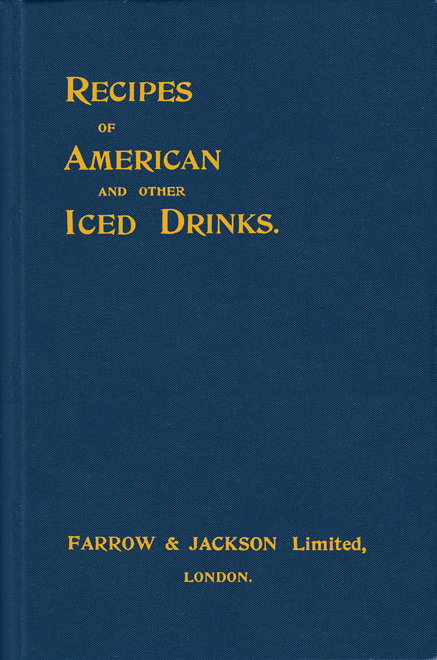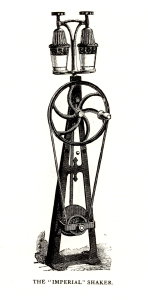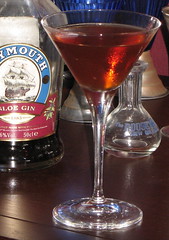Potions of the Caribbean
Continuing with the World’s Slowest and Most Procrastinatory Tales of the Cocktail recap … Jeff “Beachbum” Berry, Wayne Curtis, author of And A Bottle of Rum: A History of the New World in Ten Cocktails, Martin Cate of Alameda’s fabulous Forbidden Island tiki bar, and Stephen Remsburg, rum expert and owner of what is probably the world’s most vast private collection of rums, took us on a tour of the Caribbean, and a tasty one it was.
As fun and informative as so many of the seminars at Tales were, I think this one has to win the award for Most Entertaining Seminar, certainly winning the Best and Funniest PowerPoint Presentation Ever. Jeff got our attention with the trumpeting of the conch, began his presentation and finally called for his “laser pointer” …
“It looks like a harpoon!” you say. Yes. Yes, it does.
Jeff went on to describe Caribbean punches, the general category of which dates back to at least the 1600s, and provided for us the basic rule-of-thumb people used when concocting them: “One of sour, Two of sweet, Three of strong, Four of weak.” A little spice thrown in for good measure, and that’s a pretty good general recipe for punch. You can see some of the examples on Jeff’s slide — arrack or rum were often the strong, the latter especially in the Caribbean. Lemon or any available citrus for the sour, sugar for the sweet (natch). Water generally stood in for the weak, as did tea, which also provided a spice component. A grating of nutmeg was a typical (and quite lovely) touch atop a punch back in the day.
We got things going with a little bit of punch for ourselves, too.
Meeting House Punch
112-1/2 ounces Rhum Clément VSOP (or any good dark rum).
75 ounces Cruzan Estate Light Rum.
400 ounces Red Stripe beer.
25 ounces fresh lemon juice.
25 ounces Muscovado sugar syrup.Mix in a (very) large punch bowl. Add ice (preferably a huge block) and lemon wedges.
You might want to cut the recipe down a bit.
I had never had beer in a punch before. It was unusual but quite delicious, and not surprisingly it went really well with the citrus elements. I never was a fan of the lime wedge in the sodapop-light beer thing, but it all went together here.
Unfortunately my notes are sparse, hurried and scribbled, but there are some cryptic indications of some of the stories Jeff told, one of my favorites of which being about “sucking the monkey” — supposedly monkey carcasses being brought back to port for the taxidermist were stored in alcohol, and thirsty sailors would tap the barrels to drink it with straws, not particularly caring what was pickling inside. (Seems apocryphal; Brewer’s Dictionary of Fable and Phrase has another explanation featuring no actual monkey carcasses, as does another post about seafaring terms. I have heard, however, that bodies of officers killed in battle were preserved similarly in alcohol, and tapped by sailors dyin’ o’ da t’irst; hence, “sucking the Admiral.” Yeesh.)
Then I won a prize! Jeff called out a question, looking for a famous tiki drink containing sherry, and I got my answer out first — “The Fog Cutter!” Jeff then tossed me my Major Award — a vintage paperback copy of Thor Heyerdahl’s Aku-Aku. It was my favorite prize since I won the blackout at my high school’s Band Bingo in 8th grade. (Fifty bucks!)
We got a lot of fascinating history from Jeff about the development of Caribbean and tropical-style cocktails and bars in the States — Don the Beachcomber, primarily, in Los Angeles in the early 1930s — and then in Key West and Cuba. Hemingway entered into the story, both in his longtime exploits in Cuba as well as a ripoff bar a friend of his copied and opened in Key West. Then came one of Papa’s favorites as our next cocktail:
La Florida
(Adapted, as served at the Potions of the Caribbean seminar)1 ounce Rhum Clément VSOP.
1/8 ounce Rhum Clément Créole Shrubb.
1 ounce fresh lime juice.
1/2 ounce sweet vermouth.
1/4 ounce white crème de cacao.
1/8 ounce grenadine.Shake with ice and strain into a cocktail glass.
Wayne Curtis rose to speak, taking us further on to Cuba and the many hotel and free-standing bars in and out of Havana. Some are obviously no longer there (Trader Vic having picked an unfortunate location for his Havana outlet, the Havana Hilton, which a fellow named Fidel ended up using as his HQ for La Revolución … oops). Wayne told the tale of going to the bar in what’s left of that hotel, ordering a Mai Tai and being served something red and nasty and hideously sweet. “This is not a good argument for socialism.” Hee.
Our next cocktail! Jeff told us about the venerable Rum Pot, and offered us this adapted version:
Rum Pot
6 ounces El Dorado 12-year-old Demerara rum.
3 drops vanilla extract.
3/4 ounces passion fruit purée.
3 ounces orange juice.
3 ounces fresh lemon juice.Shake well with ice and pour unstrained into glass. Serves 3.
For some reason I had the above recipe written down, but this one came on the recipe card:
Rum Pot
(Adapted)1-1/2 ounces El Dorado 12-year-old Demerara rum.
1/4 ounce Fee Bros. French Vanilla Syrup.
1/2 ounce Funkin Passion Fruit Purée.
3/4 ounce orange juice.
3/4 ounce fresh lemon juice.Shake, strain, etc.
Heck, try ’em both!
This drink, as well as the Java Punch I made for MxMo the other day, really makes me fond of vanilla in cocktails, especially in extract form so I get the flavor without the sweetness of syrup. I’ll be playing more with this as time goes on.
Martin did a hugely entertaining slide presentation about the old island technique of making a concoction with rum and fresh pimento (allspice) berries and burying it in his backyard for six months. Marleigh noted this in her “things I learned at Tales” post — “6. Find Martin Cate’s house and dig in the backyard, because he buries jugs of punch back there!” Unfortunately I didn’t get any kind of recipe for what he made, so if anyone’s got it I’d love to see it.
Woo, and time for another cocktail! Not only that, a cocktail served to us by the lovely Jeanne Vidrine, Tiki Queen of New Orleans.
Steve Remsburg began his portion of the talk, and spoke fondly of one Jasper LeFranc, who had been head bartender at the Bay Roc Hotel in Montego Bay, Jamaica for over 30 years. This one pretty much epitomizes the best flavors that the Caribbean has to offer, is simple to make and will wow your guests:
Jasper’s Jamaican Cocktail
1-1/4 ounces Cruzan Estate Dark Rum.
1/2 ounce St. Elizabeth’s Allspice Dram (or any other allspice liqueur including homemade).
1/2 ounce fresh lime juice.
1/2 teaspoon rich simple syrup.Shake with ice until very cold and strain into a cocktail glass. Grate some nutmeg over the top.
Everything marries so beautifully here — the dark rum, the myriad spice flavors of the allspice, the tang of the lime plus that unique limey flavor … just gorgeous. If you can’t yet find St. Elizabeth’s where you live, you can use my pimento dram recipe.
Steve proceeded to give us some priceless recipes, including this one which quite possibly was worth the price of admission — Jasper’s own special rum mix, which he personally gave to Steve years ago and which he used as a base for several of his drinks.
Jasper’s Special Rum Mix
Take the freshly squeezed juice of 12-15 limes, depending on size. Pour this into a measuring cup and note the quantity.
To the fresh lime juice — you may have to transfer to a larger mixing vessel — add 1-1/2 to 2 equal measures of granulated sugar. Note the relative sweetness of the mix is entirely up to the user. In Jamaica, rum drinks are somewhat sweeter than what would be popular here. Jasper used two parts sugar.
Add 1-1/4 ounces of Angostura Bitters to the mixture. Then add 1/2 of a freshly grated nutmeg to the mixture.
Stir until the sugar is dissolved, then pour mixture into empty bottles and store in the refrigerator. Give the bottle a strong shake before each use.
Jasper used this mix in these drinks, among others:
Planter’s Punch
In a 10 ounce highball glass, pour:
1 ounce Jasper’s mix.
1-1/2 to 2 ounces dark Jamaican rum (Jasper used Appleton Dark, which is no longer sold in the U.S. — substitute Myers).Fill the glass with ice and stir vigorously. The ice will settle, so add more cracked ice to fill the glass.
Garnish with fresh mint sprigs, a sliced orange and a cherry or sliced lime — garnish any way you want.
# # #
Rum Punch
Prepare exctly as you would the Planter’s Punch, but use Wray & Nephew White Overproof Rum and garnish as you like. (W&N Overproof is the most popular rum in Jamaica, by the way.)
# # #
Witch Doctor
In a mixing can or blender jar add:
1 ounce Jasper’s mix.
1/2 ounce triple sec (Cointreau).
1/2 ounce cherry brandy (Cherry Heering).
1-1/2 ounce golden Jamaica rum (Appleton Special).Mix with crushed ice for a couple of seconds and pour drink into glass. Add ice to fill glass and garnish with an orange slice and cherry.
This was served at the Bay Roc as a cocktail over ice in an Old Fashioned glass. Steve says he prefers it as a punch in a 10 ounce highball glass, but the choice is yours.
# # #
Mule Shoe
Prepare exactly as you would the Witch Doctor, but substitute Wray & Nephew White Overproof Rum.
Steve adds, “Hope you enjoy them and that this experiment leads ot a greater appreciation that the rum really does make all the difference in the flavor of the drink. Pay attention to the rum you use, and take note of the differences they make in your drinks.”
And we’ll leave it at that, as my hands hurt from typing … I need an ergonomic keyboard!

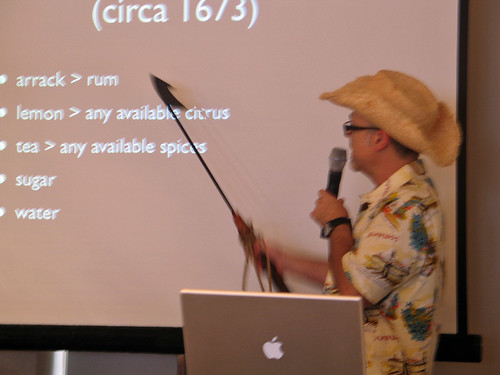
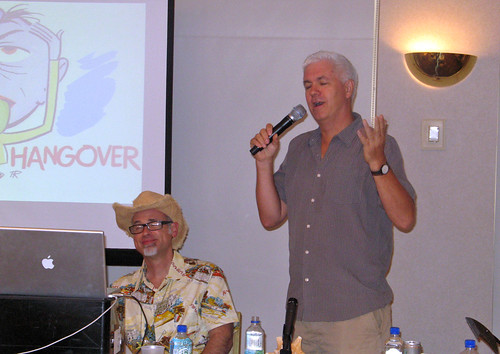
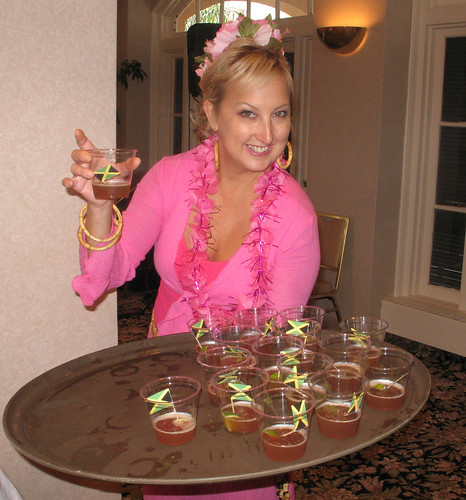
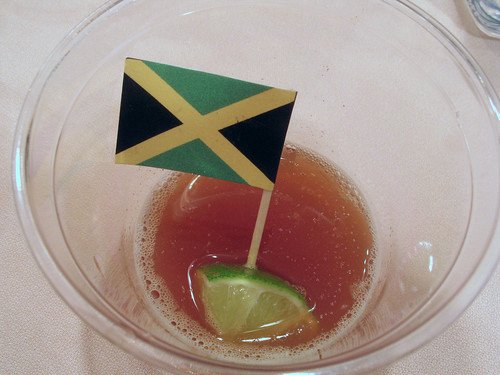
 A wonderful company called Mud Puddle Books has been releasing several once-
A wonderful company called Mud Puddle Books has been releasing several once-